Lec 21 | MIT 18.01 Single Variable Calculus, Fall 2007
TLDRThis MIT OpenCourseWare lecture delves into the Fundamental Theorem of Calculus II, illustrating its application in solving differential equations, particularly y' = 1/x. The professor corrects a previous oversight regarding the average value calculation and emphasizes the theorem's significance. The lecture explores the properties of logarithms derived from integrals and introduces various exotic functions, such as the error function and Fresnel integrals, highlighting their unique characteristics and applications. The session also covers calculating areas between curves using integrals, demonstrating two methods for finding the area between x = y^2 and y = x - 2, and concludes with a more efficient horizontal slicing technique.
Takeaways
- 📚 The lecture discusses the importance of the average value factor in calculus, emphasizing its necessity for exam problems.
- 📈 The professor corrects a previous oversight regarding the calculation of average values, highlighting the need to divide by 'n' during integration.
- 🔍 The Fundamental Theorem of Calculus, Part 2, is reiterated, which states that the derivative of an integral can recover the original function.
- 🧮 An example is provided to illustrate how the theorem can solve differential equations, specifically y' = 1/x, using integration.
- 📚 The logarithm function is defined starting from an integral, and its properties are derived from its derivative and a fixed point.
- 📉 The lecture introduces a method to graph functions defined by integrals, using the second derivative to understand concavity and inflection points.
- 📝 The concept of 'e' is defined as the value for which the natural logarithm equals one, based on the properties of the logarithm function.
- 🔢 The properties of integrals are used to prove that L(ab) is equivalent to a product of logarithms, showcasing the manipulation of integrals.
- 📉 A new function, F(x), is introduced as the integral of an exponential function, and its properties, including odd symmetry and asymptotic behavior, are discussed.
- 📚 The error function (erf) is introduced as a normalized form of F(x), which approaches the square root of pi/2 as x goes to infinity, and its importance in mathematics is highlighted.
- 📐 The lecture shifts focus to the application of integrals in calculating areas between curves, emphasizing the need for identifying integrands and limits.
Q & A
What is the correction made by the professor regarding the calculation of average value?
-The professor corrected that when calculating the average value, one must divide by 'n', especially when integrating over 0 to 'n'. This is crucial because omitting this factor would result in only getting half the marks on the exam for that problem.
What is the significance of the Fundamental Theorem of Calculus Part 2 mentioned in the lecture?
-The second version of the Fundamental Theorem of Calculus states that the derivative of an integral of a function gives you the function back. This theorem is used to solve differential equations, as demonstrated with the equation y' = 1/x.
How is the integral used to define the logarithm function in the lecture?
-The logarithm function is defined as L(x), which is the integral from 1 to x of dt/t. This definition is used as a starting point to derive all the properties of the logarithm function.
What properties of the logarithm function are discussed in the lecture?
-The lecture discusses that the logarithm function is strictly increasing, concave down everywhere, and has a derivative of 1/x. Additionally, it is specified by the function's value at L(1), which is 0.
What is the definition of the mathematical constant 'e' in the context of the logarithm function?
-The constant 'e' is defined as the value such that L(e) = 1, where L(x) is the logarithm function defined by the integral from 1 to x of dt/t.
Why is the logarithm function negative for x < 1?
-The logarithm function is negative for x < 1 because it is an increasing function that starts at L(1) = 0. Since it is increasing, it must have been negative before reaching the value 0 at x = 1.
How does the professor demonstrate the odd property of the function F(x) = integral from 0 to x of e^(-t^2) dt?
-The professor shows that F(-x) = -F(x) by using the symmetry of the function's graph and the fact that its derivative is an even function. This property implies that the graph of F(x) is the reflection of one branch over the other across the origin.
What is the limit of the function F(x) as x approaches infinity and negative infinity?
-The limit of F(x) as x approaches infinity is the square root of pi/2, and as x approaches negative infinity, it is minus the square root of pi/2.
What is the error function (erf) and how is it related to the function F(x) discussed in the lecture?
-The error function (erf) is a standard function that is closely related to the normal distribution. It is defined as 2/ the square root of pi times the integral from 0 to x of e^(-t^2) dt, which is essentially the function F(x) multiplied by 2/ the square root of pi.
How does the professor suggest finding the area between the curves x = y^2 and y = x - 2?
-The professor suggests two methods: Method 1 involves breaking the area into two parts due to the change in the lower curve from the parabola to the straight line and integrating each part separately. Method 2, which is quicker, involves using horizontal slices and integrating with respect to dy, taking the difference between the rightmost and leftmost functions at each y value.
Outlines
📚 Introduction to MIT OpenCourseWare and Average Value Correction
The script begins with an introduction to MIT OpenCourseWare, emphasizing its commitment to providing free, high-quality educational resources. Viewers are encouraged to support and visit the platform at ocw.mit.edu. The professor then corrects a previous error regarding the calculation of the average value, highlighting the importance of including a factor of 'n' during integration for a Riemann sum over the interval from 0 to n. This correction is crucial as it impacts exam performance, and the professor intends to delve deeper into the concept of average value in future lectures.
🔍 Detailed Discussion on the Fundamental Theorem of Calculus and Logarithm Properties
The script continues with a detailed discussion of the Fundamental Theorem of Calculus, specifically its second version, which states that the derivative of an integral can restore the original function. The professor uses this theorem to solve a differential equation, y' = 1/x, by integrating and defining the integral as the logarithm function. This approach allows for the derivation of logarithmic properties, such as its derivative being 1/x and its value at specific points. The professor also explains how to graph the logarithm function using its derivative and a single value, emphasizing the function's increasing nature and its behavior as x approaches 0 and infinity.
📉 Exploring the Graph and Properties of the Logarithm Function
The script delves into the properties of the logarithm function, focusing on its graph and behavior. The professor discusses the function's concavity, its increasing nature, and its limits as x approaches 0 and infinity. The concept of 'e' is introduced as the value for which the logarithm function equals 1. The professor also explains why the logarithm function is negative for x < 1, using both the function's increasing nature and an integral manipulation approach. The script concludes with an advanced property of logarithms, demonstrating how integral properties can be manipulated to show that L(ab) equals the sum of L(a) and L(b).
🌐 Introduction to Exotic Functions and Error Function
The script introduces more complex functions that cannot be expressed in terms of known elementary functions. The focus is on understanding these functions by examining their properties, such as derivatives and values at specific points. The professor discusses the function F(x), which is defined as an integral involving an exponential function. The function's increasing nature, concavity, and odd symmetry are highlighted. The script also introduces the error function (erf), which is related to the integral of an exponential function and is associated with the normal distribution. The professor emphasizes the importance of understanding the behavior of these functions at infinity and their significance in various mathematical fields.
🎲 The Role of Integrals in Cumulative Sums and Evaluating Areas
The script shifts focus to the role of integrals in calculating areas between curves, which is more closely associated with the first Fundamental Theorem of Calculus. The professor explains how to set up integrals to find areas by considering the curves as the boundaries of the region of interest. The method involves identifying the integrand, the limits of integration, and the bounds of the region. The script emphasizes the importance of these elements in calculating the area accurately and provides an example of finding the area between two curves, x = y^2 and y = x - 2, by setting up the appropriate integral.
📐 Calculating the Area Between Curves Using Vertical Slices
The script discusses a method for calculating the area between two curves by using vertical slices. The professor illustrates this with the curves x = y^2 and y = x - 2, explaining the need to split the area into two parts due to the different formulas for the lower function. The intersection points of the curves are identified, and the formulas for the top and bottom functions in each region are established. The area calculation is then set up as two separate integrals, one for each half of the area between the curves. The professor emphasizes the importance of distinguishing between the top and bottom functions and the correct application of the limits of integration.
📏 An Alternative Method for Area Calculation Using Horizontal Slices
The script presents an alternative method for calculating the area between curves using horizontal slices. This method involves reversing the roles of x and y, writing x as a function of y, and setting up the integral in terms of dy. The professor demonstrates how to find the area between the same curves, x = y^2 and y = x - 2, by identifying the limits of y and the difference between the rightmost and leftmost points. The integral is then set up from y = -1 to y = 2, and the difference between the right and left functions is used as the integrand. The professor shows that this method leads to a simpler integral and concludes the script with the final calculation, yielding the area as 9/2.
Mindmap
Keywords
💡Creative Commons license
💡MIT OpenCourseWare
💡Average value
💡Fundamental Theorem of Calculus
💡Differential equations
💡Logarithm function
💡Concave down/up
💡Error function (erf)
💡Integrals as cumulative sums
💡Area between curves
💡Riemann sums
Highlights
Correction on the concept of average value with the importance of the division factor 'n'.
Introduction to the second version of the Fundamental Theorem of Calculus, emphasizing the derivative of an integral.
Application of the Fundamental Theorem to solve differential equations, exemplified with y' = 1 / x.
Derivation of logarithm properties using integration as a starting point for understanding logarithms.
Explanation of how to uniquely specify a function through its derivative and a single function value.
Graphical approach to understanding the properties of a function, including concavity and increasing nature.
Definition of the mathematical constant 'e' using the natural logarithm function.
Discussion on the qualitative features of the graph of the logarithm function, especially for values less than 1.
Manipulation of integrals to demonstrate properties of the natural logarithm, including L(ab) = L(a) + L(b).
Introduction of the error function (erf) and its significance in integral calculus.
Explanation of the odd property of the function F(x) and its implications for graph symmetry.
Discussion on the asymptotic behavior of the function F(x) at the ends, introducing the concept of an asymptote.
Cultural overview of various integral-based functions that extend beyond standard mathematical knowledge.
Introduction to the concept of areas between curves in geometry as an application of integrals.
Methodical approach to setting up integrals for calculating areas between curves by identifying integrand and limits.
Example problem demonstrating the process of finding the area between the curves x = y^2 and y = x - 2.
Illustration of two methods for calculating areas between curves, emphasizing the importance of choosing the correct method.
Conclusion of the lecture with a summary of the integral calculations and a preview of upcoming topics, including volumes and three-dimensional figures.
Transcripts
Browse More Related Video
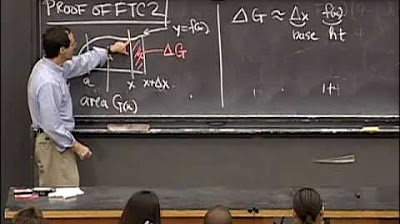
Lec 20 | MIT 18.01 Single Variable Calculus, Fall 2007

Calculus AB Homework 7.3 Area Between Curves
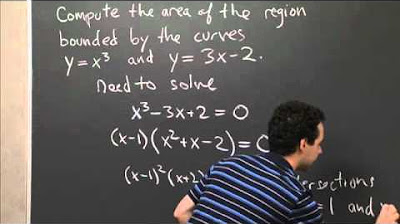
Area Between y=x^3 and y=3x-2 | MIT 18.01SC Single Variable Calculus, Fall 2010
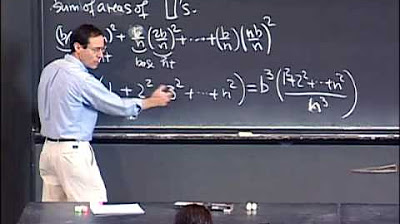
Lec 18 | MIT 18.01 Single Variable Calculus, Fall 2007
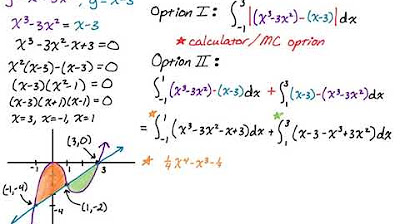
Area Between Two Curves with Multiple Regions: y = x^3-3x^2 and y = x-3
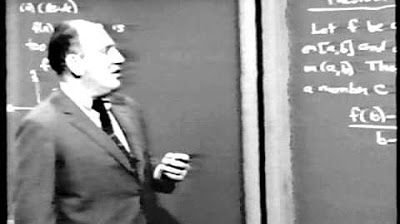
Unit II: Lec 9 | MIT Calculus Revisited: Single Variable Calculus
5.0 / 5 (0 votes)
Thanks for rating: